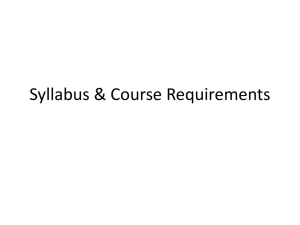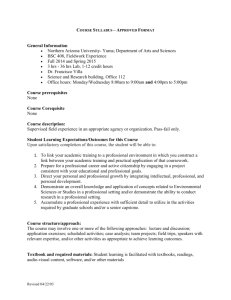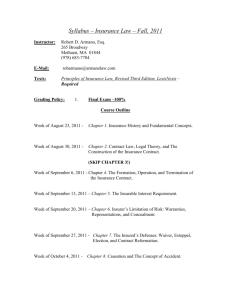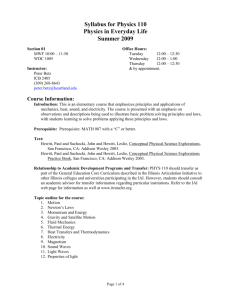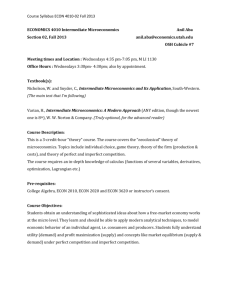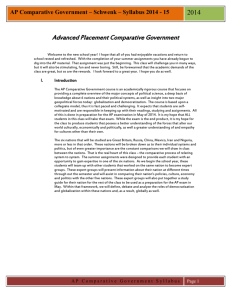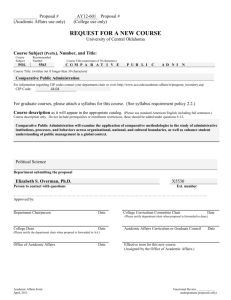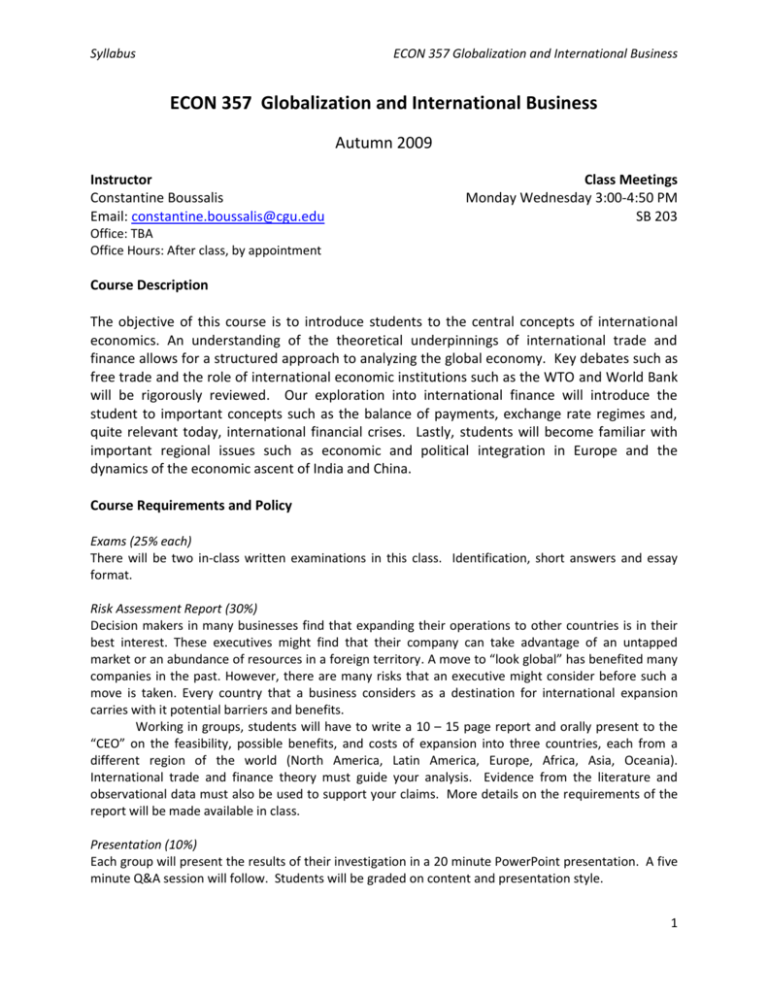
Syllabus
ECON 357 Globalization and International Business
ECON 357 Globalization and International Business
Autumn 2009
Instructor
Constantine Boussalis
Email: constantine.boussalis@cgu.edu
Class Meetings
Monday Wednesday 3:00-4:50 PM
SB 203
Office: TBA
Office Hours: After class, by appointment
Course Description
The objective of this course is to introduce students to the central concepts of international
economics. An understanding of the theoretical underpinnings of international trade and
finance allows for a structured approach to analyzing the global economy. Key debates such as
free trade and the role of international economic institutions such as the WTO and World Bank
will be rigorously reviewed. Our exploration into international finance will introduce the
student to important concepts such as the balance of payments, exchange rate regimes and,
quite relevant today, international financial crises. Lastly, students will become familiar with
important regional issues such as economic and political integration in Europe and the
dynamics of the economic ascent of India and China.
Course Requirements and Policy
Exams (25% each)
There will be two in-class written examinations in this class. Identification, short answers and essay
format.
Risk Assessment Report (30%)
Decision makers in many businesses find that expanding their operations to other countries is in their
best interest. These executives might find that their company can take advantage of an untapped
market or an abundance of resources in a foreign territory. A move to “look global” has benefited many
companies in the past. However, there are many risks that an executive might consider before such a
move is taken. Every country that a business considers as a destination for international expansion
carries with it potential barriers and benefits.
Working in groups, students will have to write a 10 – 15 page report and orally present to the
“CEO” on the feasibility, possible benefits, and costs of expansion into three countries, each from a
different region of the world (North America, Latin America, Europe, Africa, Asia, Oceania).
International trade and finance theory must guide your analysis. Evidence from the literature and
observational data must also be used to support your claims. More details on the requirements of the
report will be made available in class.
Presentation (10%)
Each group will present the results of their investigation in a 20 minute PowerPoint presentation. A five
minute Q&A session will follow. Students will be graded on content and presentation style.
1
Syllabus
ECON 357 Globalization and International Business
Participation (10%)
Students are expected to attend every class meeting and are responsible for participating in class
discussions. Absence due to a family emergency or severe illness is allowed but the instructor must be
informed before class.
Cheating and Plagiarism
Please don’t. The La Sierra University Administration will be contacted if a case of cheating or plagiarism
arises. See the handout on plagiarism distributed in class. If you are paraphrasing, cite the source. If
you are quoting, use quotation marks and appropriate citation. Remember that academic integrity is a
reflection of one’s character.
Make-up Exams, Late Work and Incompletes
Only under extraordinary circumstances will the instructor allow for a make-up examination. Late work
will be penalized a whole letter grade. Incompletes will be allowed only for family or illness reasons.
Required Text
James Gerber. 2008. International Economics. Fourth Edition. Pearson Addison Wesley.
ISBN: 978-0-321-41555-4
Reading Assignments and Course Schedule
*Note that this schedule is tentative and that the instructor reserves the right to alter elements at any
time.
Meeting 1 – September 21st
Course Introduction / Historical overview of Global Trade, 1400-1800
Chapter 1. The United States in a Global Economy
Meeting 2 – September 23rd
Chapter 2. International Economic Institutions since World War II
Meeting 3 – September 28th
Chapter 3. Comparative Advantage and the Gains from Trade
Chapter 4. Comparative Advantage and Factor Endowments
Meeting 4 – September 30th
Chapter 5. Beyond Comparative Advantage.
Meeting 5 – October 5th
Chapter 6. The Theory of Tariffs and Quotas
Meeting 6 – October 7th
Chapter 7. Commercial Policy
Meeting 7 – October 12th
Chapter 8. International Trade and Labor and Environmental Standards
Meeting 8– October 14th (FIRST EXAM)
2
Syllabus
ECON 357 Globalization and International Business
Meeting 9 – October 19th
Chapter 9. Trade and the Balance of Payments
Meeting 10 – October 21st
Chapter 10. Exchange Rates and Exchange Rate Systems
Meeting 11 – October 26th (Firm and Expansion Report Due)
Chapter 11. An Introduction to Open Economy Macroeconomics
Meeting 12 – October 28th
Chapter 12. International Financial Crises
Meeting 13 – November 2nd
Corruption and Ease of Doing Business
Smith (2007) A Culture of Corruption, Introduction
Meeting 14 – November 4th
Chapter 17. China and India in the World Economy
Meeting 15 – November 9th
Chapter 13. Economic Integration in North America
Meeting 16 – November 11th
Chapter 14. The European Union: Many Markets into One
Meeting 17 – November 16th
Chapter 15. Trade and Policy Reform in Latin America
Meeting 18 – November 18th
Chapter 16. Export-Oriented Growth in East Asia
November 21st – 29th (THANKSGIVING BREAK)
Meeting 19 – November 30th (PRESENTATIONS)
Meeting 20 – December 3rd (REVIEW)
Meeting 21 – December 7th through 10th (SECOND EXAM)
3

